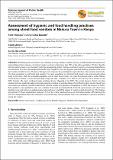Assessment of hygienic and food handling practices among street food vendors in Nakuru Town in Kenya
Publication Date
2014-11-10Type
Article, Journalviews
downloads
Metadata
Show full item record
Abstract/
Withstanding the test of time, the precarious working condition; and the ministry of public health and sanitation not acknowledging their existence, street food vendors continue to feed more than 50% of the urban population. Whether illegally into the market system or not, the reality is that the unsuspecting public continue to put itself at risk by consuming foods that are not monitored. It is from this background that the study sought to assess the hygienic and food handling practices of the street food vendors in Nakuru town. The aim of this paper is to empower the general public especially those who consume street foods. The study population was all street food vendors. The target population was all street food vendors who cook and sell cooked foods on the street, while the accessible population was all street food vendors who meet the inclusion criteria within Nakuru central business district. A cross-sectional study design was used. A sample size of 384 was arrived at by use of Fischer’s et al, 2008, formula. The study employed cluster sampling design (Mugenda et al, 2003). The central business district was then clustered into four quadrants and proportionate sampling was done. A sampling frame of street food vendors was developed from each cluster and randomly sampled to identify the required number of respondents, (Mugenda et al., 2003 and Ahuja et al., 2006). Both qualitative and quantitative data was collected. Pre-tested and standardized structured questionnaires and observation checklist were used. Data was analyzed using Microsoft-excel and SPSS version 17 and presented descriptively. The findings showed that 83% had a cleaned their workplace, 54% of the vendors handled money and food indiscriminate, 44% had dust bins and 73% of respondents did not have their hair covered. The study recommends the concerned stakeholders to promote sanitation among the vendors

